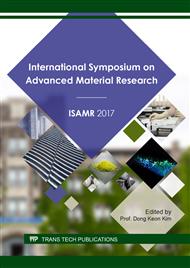[1]
M. Lachemi, K. M. A. Hossain, M. Shehata, W. Thaha, Controlled low-strength materials incorporating cement kiln dust from various sources, Cem. Concr. Compos. 30 (2008) 381-392.
DOI: 10.1016/j.cemconcomp.2007.12.002
Google Scholar
[2]
ACI, Controlled low-strength materials (CLSM): reported by ACI Committee 229, (1999).
DOI: 10.2172/505263
Google Scholar
[3]
R. Siddique, Utilization of waste materials and by-products in producing controlled low-strength materials. Resour. Conserv. Recy. 54 (2009) 1-8.
Google Scholar
[4]
M. A. Gabr, J. J. Bowders, Controlled low-strength material using fly ash and AMD sludge, J. Hazard. Mater. 76 (2000) 251-263.
DOI: 10.1016/s0304-3894(00)00202-8
Google Scholar
[5]
H. Sutar, S. C. Mishra, S. K. Sahoo, A. P. Chakraverty, H. S. Maharana, Progress of red mud utilization: An overview, Am. Chem. Sci. J. 4 (2014) 255-279.
Google Scholar
[6]
J. Yang, B. Xiao, Development of unsintered construction materials from red mud wastes produced in the sintering alumina process, Constr. Build. Mater. 22 (2008) 2299-2307.
DOI: 10.1016/j.conbuildmat.2007.10.005
Google Scholar
[7]
T. M. Do, Y. S. Kim, Engineering properties of controlled low strength material (CLSM) incorporating red mud, Int. J. Geo. Eng. 7 (2016), doi: 10. 1186/s40703-016-0022-y.
DOI: 10.1186/s40703-016-0022-y
Google Scholar
[8]
A. Kumar, S. Kumar, Development of paving blocks from synergistic use of red mud and fly ash using geopolymerization, Constr. Build. Mater. 38 (2013) 865-871.
DOI: 10.1016/j.conbuildmat.2012.09.013
Google Scholar
[9]
ASTM, Standard test method for compressive strength of hydraulic cement mortars (Using 2-in. or [50-mm] cube specimens), C109. In: Annual book of ASTM standards, 04(01) (2016).
DOI: 10.1520/c0109_c0109m-20
Google Scholar
[10]
ASTM, Standard test method for flow consistency of controlled low strength material (CLSM), D6103. In: Annual book of ASTM standards, 04(09) (2004).
Google Scholar
[11]
ASTM, Standard test method for time of setting of concrete mixtures by penetration resistance, C403. In: Annual book of ASTM standards, 04(02) (2008).
Google Scholar
[12]
K. L. Lin, N. F. Wang, J. L. Shie, T. C. Lee, C. Lee, Elucidating the hydration properties of paste containing thin film transistor liquid crystal display waste glass, J. Hazard. Mater. 159 (2008) 471-475.
DOI: 10.1016/j.jhazmat.2008.02.044
Google Scholar
[13]
P. Nath, P. K. Sarker, Effect of GGBFS on setting, workability and early strength properties of fly ash geopolymer concrete cured in ambient condition, Constr. Build. Mater. 66 (2014) 163-171.
DOI: 10.1016/j.conbuildmat.2014.05.080
Google Scholar
[14]
M. Lachemi, M. Şahmaran, K. M. A. Hossain, A. Lotfy, M. Shehata, Properties of controlled low-strength materials incorporating cement kiln dust and slag, Cem. Concr. Compos. 32 (2010) 623-629.
DOI: 10.1016/j.cemconcomp.2010.07.011
Google Scholar
[15]
C. L. Hwang, T. P. Huynh, Effect of alkali-activator and rice husk ash content on strength development of fly ash and residual rice husk ash-based geopolymers, Constr. Build. Mater. 101 (2015) 1-9.
DOI: 10.1016/j.conbuildmat.2015.10.025
Google Scholar
[16]
J. He, Y. Jie, J. Zhang, Y. Yu, G. Zhang, Synthesis and characterization of red mud and rice husk ash-based geopolymer composites, Cem. Concr. Compos. 37 (2013) 108-118.
DOI: 10.1016/j.cemconcomp.2012.11.010
Google Scholar
[17]
C. L. Hwang, T. P. Huynh, Investigation into the use of unground rice husk ash to produce eco-friendly construction bricks, Constr. Build. Mater. 93 (2015) 335-341.
DOI: 10.1016/j.conbuildmat.2015.04.061
Google Scholar


